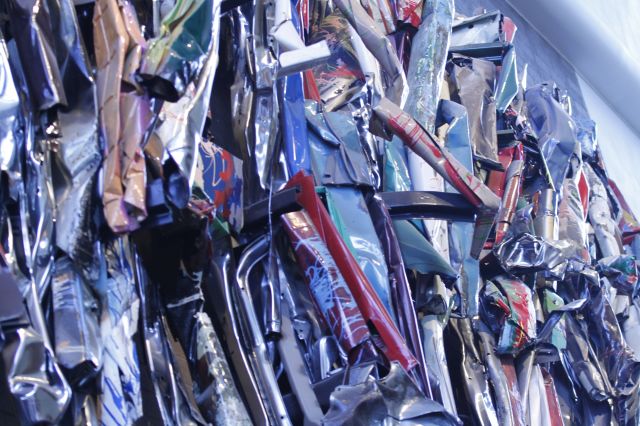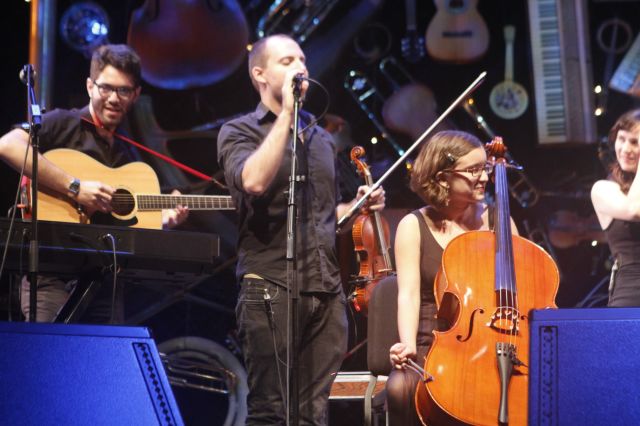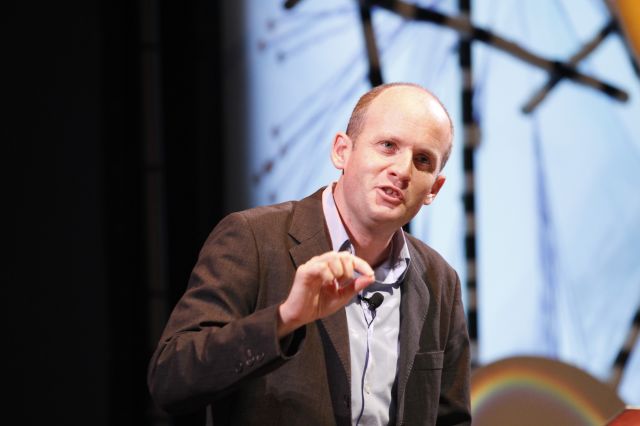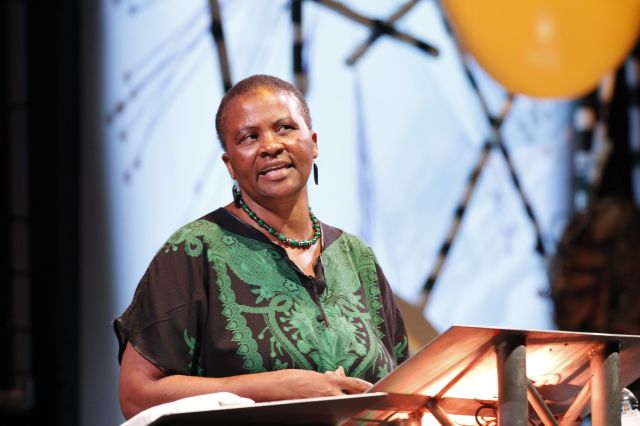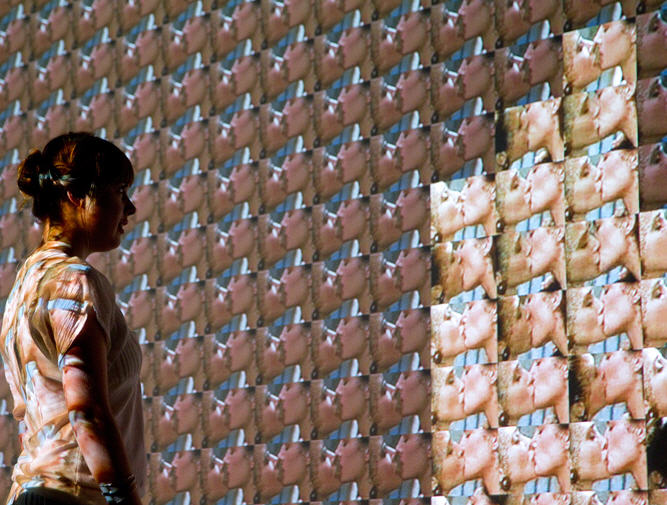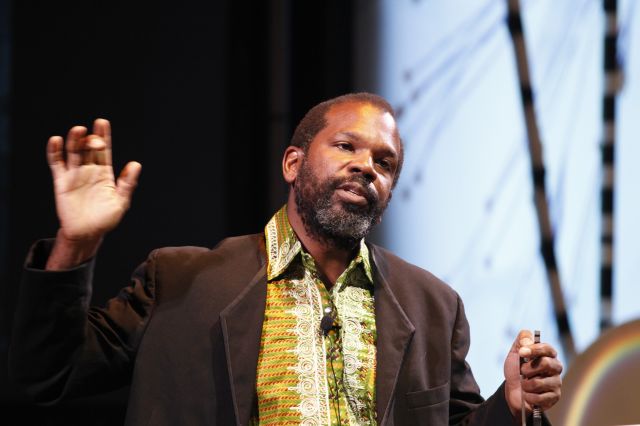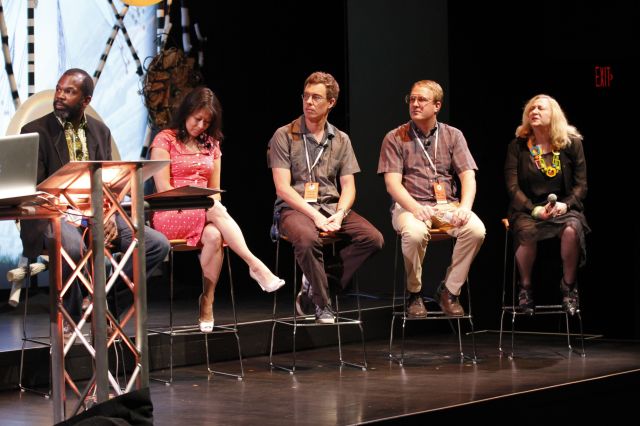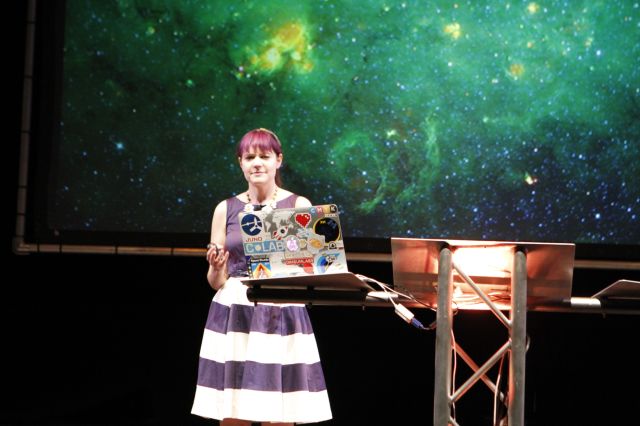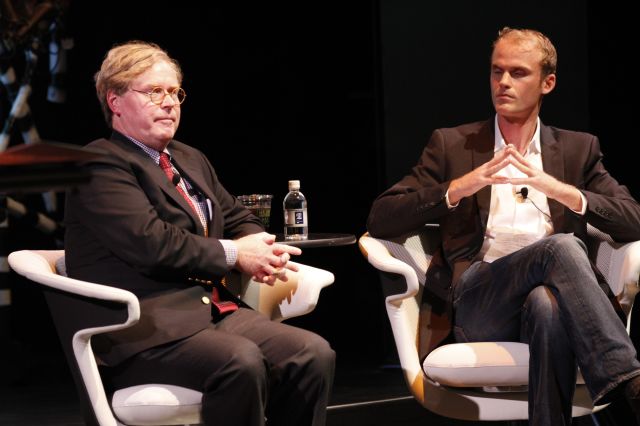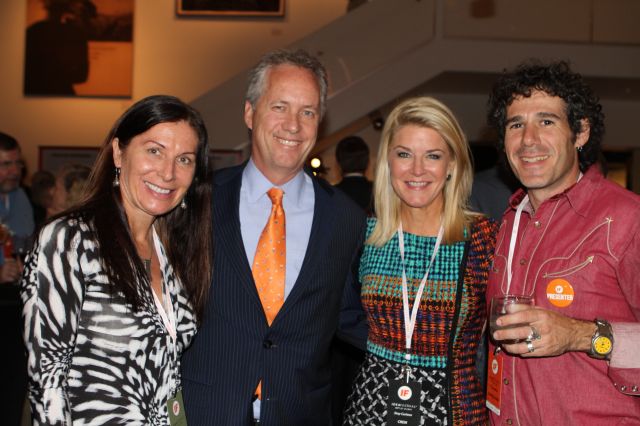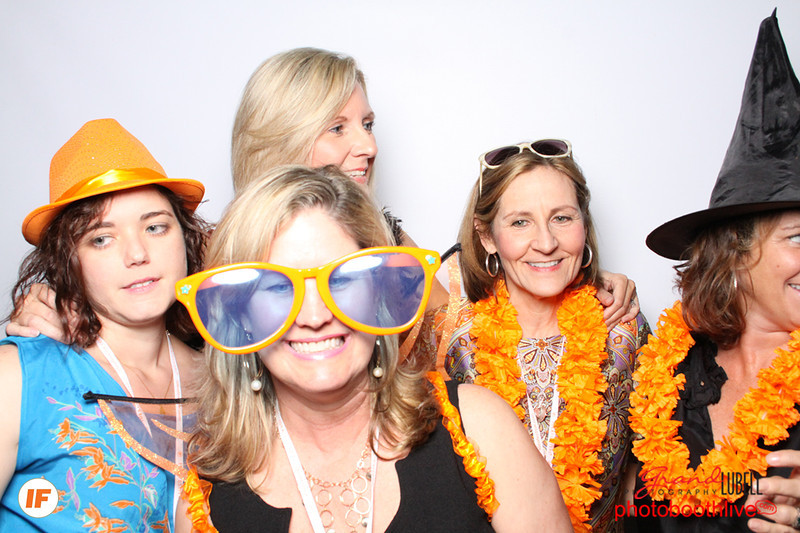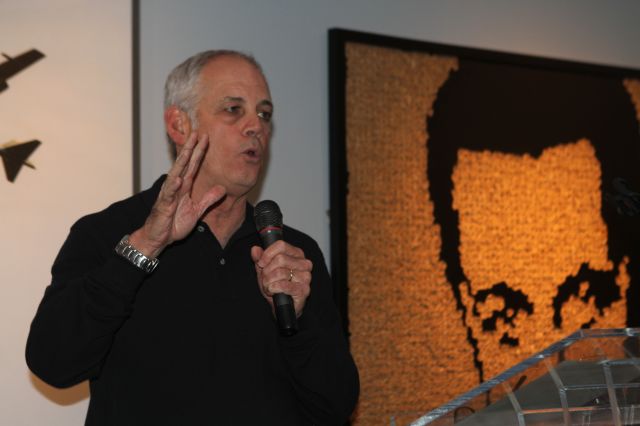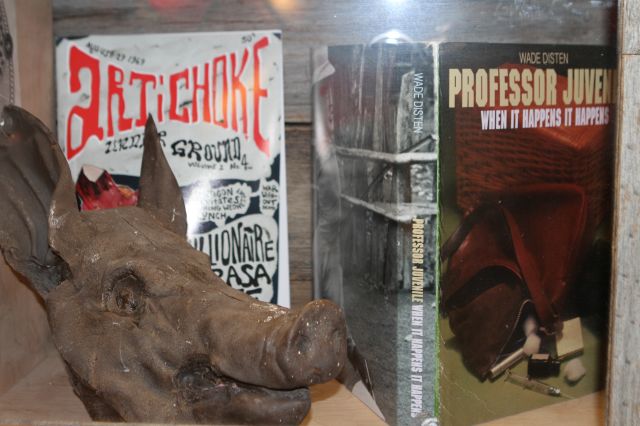Idea Festival is an event I have been attending for the last few years now based in Louisville Kentucky. It is held every year at the Kentucky Performing Arts Center in downtown Louisville and surrounding the event are various activities off-site, which range from sustainable gardening and education to art, music and food. (see our write-up on last year’s Taste of Innovation at the renowned Churchill Downs and our top three restaurant picks — note that this year’s review of the annual foodie event went live on October 12).
From the start, We Blog the World has been a media partner and were again this year…keen to to support the efforts of founder Kris Kimel and his fabulous team who work relentlessly over the year to ensure there’s a compelling and well curated set of speakers and attendees. Their tagline which is “stay curious” and goals center around enlightenment, education and acceleration for the positive good. See our write-up from last year’s Idea Festival.
I always love their musician and performer picks every year and once again was blown away by the very young 17-member chamber-rock collective group called Mother Falcon, who I’d describe as energizing, fun alluring and empowering all in one package.
NPR said, “unlike The Polyphonic Spree, though, everyone in Mother Falcon plays an instrument during this performance: there’s no chorus of backup singers among the 17 men and women who play guitars and horns and keyboards and woodwinds and strings here…..which made Tetris-ing each member behind Bob’s desk a bit of a challenge, but Mother Falcon knows its way around cramped spaces.” Don’t take our word for it – have a listen to their performance on NPR.
There were also a wide range of speakers from multiple disciplines, ranging from nature and the environment to music, science, education, food, medicine and everything in between.
Nature Trumps Politics:
Marine biologist Rafe Sagarin who teaches kids from a more modern framework would prefer to teach without a structured syllabus since he feels it limits potential growth, learning and possibilities. The main is clearly passionate about biology and the environment and as an ecologist, writer, artist, and expert on adaptation, his talk focused on what we can learn about nature and biology to adapt, survive and thrive in an unpredictable world. His two recent books Learning from the Octopus: How Secrets from Nature Can Help Us Fight Terrorism, Natural Disasters, and Disease and Observation and Ecology: Broadening the Scope of Science to Understand a Complex World also address the topic.
He says, “Nature trumps Politics and Biology trumps Politics. They’re intently focused on solving problems and getting focused rather than on perfection.” In other words, give up perfection and embrace adaptability. Nature doesn’t succeed by trying to be perfect but by being adaptable. Rafe discussed it in a few steps, starting with change and the ability to observe change, which they do in nature all the time. Animals and marine life observe change and then respond to it as quickly as possible, either by moving or expanding their ability to adapt to the change in the same place.
Apparently, our immune system does this automatically but humans tend to centralize things when we feel fear. Katrina and 9/11 are good examples of how we did this and didn’t learn from our mistakes. He cites the fascinating work of Geerat Vermeij, a blind professor and researcher who had scientific vision. He looks at patterns and has discovered that the most successful orgasms have some decentralized way to sense change in the world. Through Rafe’s research, he has learned that nature often uses redundancy to solve a problem and creative redundancy allows you to solve lots of different kinds of problems. He even notes that some of the most successful companies use redundancy, such as Southwest, where every mechanic and pilot knows how to fix and fly every aircraft so they can be more efficient, supporting the point that redundancy and creative adaptability is more efficient than centralized systems. And, Google uses us (our information) as decentralized tools as a way to improve knowledge and search.
When we (humans) see conflict we tend to build up walls but every biology gets broken, even between sea and air. Things are constantly getting broken and rebuilt, which of course made me think of spider webs and how often they get destroyed and need to be remade. Additionally, when an orgasm needs to adapt, they reach out to other orgasms to survive through the symbiosis process. An example in business is the relationship between Unilever and Ben and Jerry’s who both learned from each other – Ben & Jerry’s could become more profitable and Unilever could integrate some of the cool factor aspects & giving back to community that Ben & Jerry’s so excels at. Symbiosis breaks through walls!
Says Rafe, “another lesson we can learn from nature is absorbing what we have learned from success and then repeating it, a process that every orgasm builds from. If an orgasm doesn’t learn from success, it doesn’t actually survive.” He asserts that we need to use these examples and apply them to how we respond to disasters and unpredictable situations – from terrorism to climate change and global markets. He adds, “adaptation leads to emergence … also known as serendipity. When decentralized systems don’t work very well, let’s look at the lessons we can learn from nature over 3.5 billion years. ” Hear hear.
The Health and Farming Connection:
Dr. Daphne Miller is a doctor in the San Francisco area, who has long suspected that farming and medicine were intimately linked. She also wrote a book called Farmacology that emerged from her travels about sustainable health and healing. She used to think farmers markets would be great to grow a community until she met this woman in the Bronx who started urban gardens and was blown away by what she learned. She says, “what matters is that there’s something between the gardens and the people. Urban farming is regenerative and healing in healthcare and should be funding at the same level as the brick-and-martyr healthcare.”
She has been increasingly disillusioned by mainstream medicine’s mechanistic approach to healing and fascinated by the farming revolution that is changing the way we think about our relationship to the Earth. She left her medical office and traveled to seven innovative family farms around the country, on a quest to discover the hidden connections between how we care for our bodies and how we grow our food.
From the Bronx to wineries in Northern California, she made some interesting discoveries. Daphne referenced raw lessons learned from a vineyard owner’s early days farming his land. After discovering rattlesnakes in his fields, his initial decision was to get rid of the snakes until he realized that rodents were starting to eat his roots. It was this lesson that made him start to think about his land differently and that it wasn’t about a war between insects and humans but that everything should be in sync and in balance. In other words, humans, rattlesnakes, weeds, sheep and vine rot can all be in balance.
She asserts that what is good for the soul is really what is good for our entire system! Nutrients that are healthy for the soil are also good for our health, positively serving our immune system and our stress. In other words, “we are the soil. When we treat the soil like we treat ourselves, then everything changes. If we only start to put things into the soil that we would eat ourselves, then our health will improve — the entire ecosystem will transform.
Choosing Happiness Or Negative Visualization?
Oliver Burkeman wrote a book with an amusing title — well, at least some people think so. Happiness…for People Who Can’t Stand Positive Thinking seems like the kind of title a British author would come up with, doesn’t it? After all, when I lived in the UK (God bless the Brits), they weren’t too happy about people being, well…..too happy. Burkeman, who also works at The Guardian (my favorite paper when I lived in London), suggests that when we try too hard to accomplish things or to achieve our goals, the opposite effect can often happen.
His plan (or rather his approach) is centered around Negative Thinking Tools. Yes, really. Let’s look at some of them:
1. Rather than focus on positive thinking, focus on how badly things could really go. Negative visualization? He says with a chuckle, “If you’re grouchy like I am, it’s hard to just turn on gratitude but if you focus on the worst scenario, it may be easier to value things for what they are and not take them for granted.” His take is that it can be a great anecdote to anxiety aka defensive pessimism. In other words, when you enforce that things will be just fine but if they didn’t turn out fine, then perhaps it would be better to focus on the dramatic opposite. When you exaggerate the outcome, then you realize that perhaps you have over exaggerated your beliefs. By bringing your beliefs into a place of more clarity, you may realize that your anxiety was much more extreme than you really thought. There’s also the principle of exaggerated loss. Ask yourself – what’s the worst thing that could happen here and can I afford it? (or handle it?). Our emotional reactions when we don’t think too hard about them are often less severe than we imagine them to be!
My Personal Take: I do believe that thinking about the worst outcome can make you put things into a more realistic perspective, and I also agree that bringing your beliefs and fears into a place of clarity and “reality” can do wonders for getting you to see a lighter side to a negative story. Anxiety and fear drive so many of beliefs. That said, I’m a huge believer that positive thinking does work, particularly as it pertains to visualization and language. For example, try saying the following aloud: “I suck at Math and have always sucked at Math.” Now, try saying “I ace English and Biology and they’re my strongest subjects whereas Math isn’t my cup of tea.” It literally “feels” differently. A more positive spin on words that you choose can literally change your mood, your attitude and your body chemistry, so while I buy into part of what he’s saying, I don’t buy into negative visualization as a way to turn on gratitude and appreciation.
2. Practice Non Attachment. Non attachment is something that the Buddhists tout. Separating yourself from being attached so intensely to the outcome can be an effective way of not getting drawn into the drama.
My Personal Take: I’m a strong believer in non-attachment, particularly attachment to things and people, which can be negative drivers for our fears and anxiety. While it’s not easy to do, it can be very free-ing and relaxing if you allow yourself to go through the process.
3. Uncertainty can be a really creative force. In situations of uncertainty, creativity can truly unfold. Uncertainty is the condition for man to tap into his best powers.
My Personal Take: So many things in our life is uncertain – when we let go of the notion that we have to be sure about everything, we let go of control….both of our own lives and those in our ecosystem. Alas, more freedom and yes, potentially more creativity. In other words baby, let it go.
4. Remember that you’re going to die. I couldn’t help but think: only a Brit can get away with this one on a festival stage or perhaps a Canadian who has lived in the UK for awhile. It’s true that death is something we try hard not to think about. As a society, we ban the process of death in a bad way and try to deny it.
My Personal Take: Many other cultures in my travels do embrace death in a more positive light and frankly, sometimes I wonder if the happiest nations are the ones who do integrate it, talk about it and embrace it rather than avoid it or as we do in the west, deny that it’s coming for as long as we can. Perhaps if we did make an effort to integrate death into the context of our lives in a very different way, a more grounded and positive way, we may be less fearful and anxious about it and everything that is connected to it.
He essentially argues that we have taken “over positive thinking” to an extreme in the west, which he thinks means that we are denying half of our humanity and what it means to be half human. He refers to the work of Japanese philosopher Shoma Morita (otherwise referred to as Morita Masatakeand Morita Shoma). One of his quotes, which is heavily influenced by Zen Buddhism is: “Give up on yourself – take action now by embracing best imperfect person you can be.”
Says Oliver, “it’s the struggle to feel secure that makes you feel secure. When you are off center or on the outskirts as a separate atom, that is when feel most vulnerable. When you are vulnerable, you are more likely to be open and connect with humans at a deeper level.”
Women, Education & Human Rights:
From negative visualization and nuking positive thinking to biology, farming and medicine, we also turned to education and human rights at the conference. A true delight to the Idea Festival stage was African born Tererai Trent who has a remarkable personal story that demonstrates the best of resilience. She talked about the importance of women’s rights and believing in other people’s dreams and aspirations. I’m always so amazed at how often women bring this up as the vital element to their success (mentorship, having someone believe in them along the way, not giving up on them) and still how little we see best practices implemented in traditional schools and communities across the world.
A true inspiration, she shared her own life story with us, which started as a girl who wasn’t allowed to go to school and was later beaten by her husband for wanting to. While more women in developing countries are getting educated, there are still an astonishing number of girls who remain at home and do not go to school. Globally we have 8 million who can’t read and write and two thirds of them are women and girls. Another horrifying stat: 34 million are living with HIV and Aids, 23 million of those are in Africa and the Sahara and so many of those millions are women and girls because of their lack of education. She asserts that there’s a lot of gender violence which makes women much more vulnerable to HIV & Aids.
She was told by her mother to write down her dreams and bury them in the dirt so no one would find them….in other words, men who would hold her back or try to squash her dreams. She says that by writing them down, the dreams will always remind you of what is important. Her mother had said to her over and over again: Believe in something and believe with all your heart that you will achieve them. Her mother also said to her that it wasn’t just about achieving your own dreams but how those dreams would then tie back to your community. And so, Tererai buried her dreams and took ten years to get her GED. She then made it to the states and went to university and after achieving educational goals beyond her wildest dreams, rather than stay in the states, she kept hearing her mother’s nagging voice in the background telling her to bring her skills and influence back home and serve the community. It was this nagging voice that inspired her to return to Africa and build a school in her village, the same village that denied her an education because she was a girl.
Today in partnership with Oprah Winfrey and Save the Children, the school has just been completed and will serve 4,000 students by 125 teachers who have been trained. See the incredibly inspiring video of Tererai on the Oprah show telling her story and Oprah’s public commitment to help her build the school in Africa.
Oh Tererai, you are such an inspiration! I didn’t bother fighting the tears that rolled down my face as I watched you speak on stage. Thank you for the mascara run – it was so worth it. And, thank you for saying this at the end of your talk — I couldn’t agree more except for the detail that you think that you were an ordinary girl. You were and are beyond extraordinary and in case others haven’t flooded you with that observation, I’ll do it publicly here.
“I’m just an ordinary girl from a small village in Africa but I was blessed to be given an opportunity to change the blueprint in my life. I want every child to have that opportunity.
I want everyone to believe in their dreams and that they’re achievable. We all have a role to make education possible for everyone” — Tererai Trent
Moving Onto Art:
It wouldn’t be Idea Festival without Creative Capital’s Ruby Lerner and her entourage on stage. She brings several artists to Louisville every year to tell their story and among them this year were a few incredible standouts in a session called Art @ The Edge: (by the way, all of the artists she discovers have amazing stories, so be sure to check out their work).
Elaine Tin Nyo is an exile from Burma who now lives in Harlem. Burmese food is central to her earliest memories, and since the early 1990s, food has been a vehicle for the artist to explore issues of mortality and responsibility. She has received project support from the Bronx Museum, Seoksu Art Project, Franklin Furnace and The Phillips Collection, among others, and her photographs, food, videos, installations and performances have been presented at New Museum, Deitch Projects, Creative Time, Färgfabriken, Brooklyn Museum, Josée Bienvenu Gallery, Postmasters Gallery, the French Culinary Institute and more. She’s currently working on a pig project, where she is adopting and following pigs from five parts of the world — from start to the end of their lives (yes, the ole butchery) and then plans to create a cookbook from it. Quirky, funny and creative, be sure to follow this project and Elaine’s journey.
Rafael Lozano-Hemmer is an electronic artist who develops interactive installations that are at the intersection of architecture and performance art. His main interest is in creating platforms for public participation, by perverting technologies such as robotics, computerized surveillance or telematic networks. Inspired by phantasmagoria, carnival and animatronics, his light and shadow works are “antimonuments for alien agency”.
Confused yet? Perhaps a visual will help! Yes, they’re often large in size and these often massive in size interactive installations have been commissioned for events such as the Millennium Celebrations in Mexico City, the Cultural Capital of Europe in Rotterdam, the UN World Summit of Cities in Lyon, the opening of the YCAM Center in Japan, the Expansion of the European Union in Dublin, the 50th Anniversary of the Guggenheim Museum in New York and others. The man has been given international acclaim for his work, which has been shown at Havana, Istanbul, Liverpool, Montréal, Moscow, New Orleans, Panama, Seoul, Seville, Shanghai, Singapore, Sydney and others.
Paul Rucker is an interdisciplinary artist based in Maryland who has received numerous grants for visual art and music from 4Culture, the Seattle Mayor’s Office of Arts and Cultural Affairs, the South Carolina Arts Commission, the Washington State Arts Commission, the Photo Center NW, Artist Trust and others. Rucker has been awarded residencies at the Headlands Center for the Arts, Blue Mountain Center, Ucross Foundation, Art OMI, Banff Centre, Pilchuck Glass School, and the Rockefeller Foundation Study and Conference Center in Bellagio, Italy. As a musician and musical director, Rucker plays in various situations ranging from solo cellist to leading his Large Ensemble of 22 musicians.
Ariel Waldman, who is the founder of Spacehack.org, a directory of ways to participate in space exploration, and the global instigator of Science Hack Day, ended up transforming her career after a stint in NASA, one she managed to nail despite the fact that she didn’t have any science experience. Fascinated by science throughout her life however, she has used her experience at NASA to bring together scientists, technologists, designers and people with good ideas to see what they can create in one event. Last year, she authored a white paper on Democratized Science Instrumentation that was presented to the White House Office of Science and Technology Policy and talks around the country on science and hacks among other things.
She shared one amusing and creative story after another about the various inventions and creations which have come out of her hack days. The notion is that when you have an open mind and encourage people to build from the ground up and encourage their passion, it’s amazing the kind of innovation that gets sparked.
Let’s Throw a Little History Into the Mix:
Cullen Murphy joined Vanity Fair’s editor at large Culley Murphy took us on a journey back to Rome. He used his most recent book, Are We Rome? The Fall of an Empire and the Fate of America, as an example of where fate falls for America based on what we have learned from Rome, its history, its behavior at certain cycles and where we are today as a nation. He has also written other books over the years, among them Rubbish! The Archaeology of Garbage, with co-author William L. Rathje, the essay collection Just Curious, and The Word According to Eve: Women and the Bible in Ancient Times and Our Own.
What We Can Learn From African Warriors:
I didn’t meet Wilson and Jackson until an after party although they presented early on at the event. Coined The Last Maasai Warriors, they are a living testament to a vanishing way of life on the African savannah. Wilson and Jackson are proud to be from a culture built on countless generations steeped in the mystique of tradition, legend and prophecy.
They represent the final generation to fight for their way of life, coming of age by proving their bravery in the slaying of a lion. While they may be the last of the great warriors, they are also the first generation to fully embrace the modern ways and teachings of Western civilization, and in doing so, they are trying to help integrate modern technology and culture into their community in a way that is healthy and collaborative. As you would expect with such a remarkable journey, as their struggle to achieve this balance unfolds, their discoveries resonate well beyond the Maasai Mara. The insights and shared stories were lessons we could all integrate into our own lives in the west. Balance grasshopper, balance!
As always, the mayor of Louisville supports the efforts of the festival and showed up on a couple of occasions, which included paying respect to these two Maasai heroes.
Above: Renee Blodgett, Mayor Gregory E. Fischer, Tonya York Dees and speaker Rafe Sagarin.
While I didn’t cover every speaker at the event, consider it a taste of some of Idea’s Festival eclectic diversity of topics which are discussed on the main stage. Each year, handfuls of high school students attend the event from local schools who show up prepared with thought provoking questions for the speakers — their intellectual wit and insights blew attendees away, as MIT Technology Review’s Jason Pontin, who moderated a few of the speaker sessions, pointed out on more than one occasion.
A festival doesn’t come without (or shouldn’t anyway) a little corniness. A photo booth was set up to….well, play!
Then, there was Balloon Man, who was also working on his own talented creations. Yes, her bra and skirt really are made of balloons!
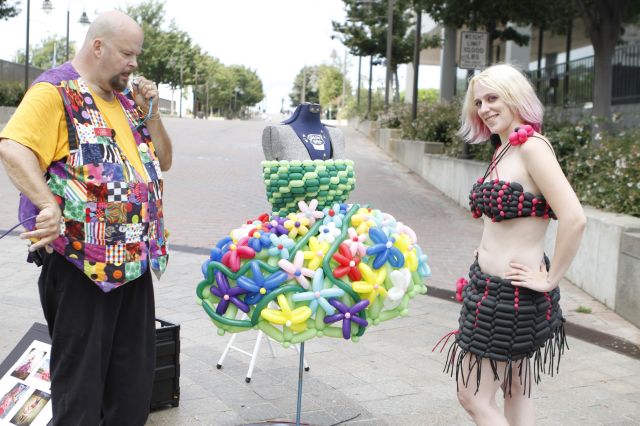
Below Idea Festival founder Kris Kimel does a wrap.
I ended up at the renowned Churchill Downs racetrack twice this year, a venue you’ll want to take in when you hit Louisville, regardless of whether you’re there for Idea Festival or not.
Of course, it’s not over until it’s over. Sluggish and beat but still full of engaging stories, groups and sub-groups gathered nightly at the 21c Hotel & Bar, where we shared insights from the days’ speakers and performers.
21c, where I stayed last year, is a modern and hip hotel with a host of simple pleasures (see our write up on it from last year). Below is a shot taken in one of its funkier suites, known as the 1970s Pad or the Flower Child Suite depending on who you talk to.
It is officially called the Cyclone, which is a 500 square feet immersive art experience that happens to have a functional bed in it. I attended an after party here and was trying to imagine how I would sleep soundly with this much stimuli but it was way too cool not to want to try it out one day. It was designed by New York-based artists Jonah Freeman and Justin Lowe — have a look!
Idea Festival is full of surprises on and off the floor and inside and outside of the official venue. The attendees are curious and innovative, the performers magical and soulful and the speakers inspiring and engaging, all adding richness to a unique experience you’ll want to add to your agenda for next year!
Check out our Kentucky Events section, which will include coverage of Idea Festival 2011 and Idea Festival 2012 and also our Kentucky Food & Wine section where you’ll find plenty of recommendations and visual treats on the top Louisville Restaurants.

Renee Blodgett is the founder of We Blog the World. The site combines the magic of an online culture and travel magazine with a global blog network and has contributors from every continent in the world. Having lived in 10 countries and explored nearly 80, she is an avid traveler, and a lover, observer and participant in cultural diversity.
She is also the CEO and founder of Magic Sauce Media, a new media services consultancy focused on viral marketing, social media, branding, events and PR. For over 20 years, she has helped companies from 12 countries get traction in the market. Known for her global and organic approach to product and corporate launches, Renee practices what she pitches and as an active user of social media, she helps clients navigate digital waters from around the world. Renee has been blogging for over 16 years and regularly writes on her personal blog Down the Avenue, Huffington Post, BlogHer, We Blog the World and other sites. She was ranked #12 Social Media Influencer by Forbes Magazine and is listed as a new media influencer and game changer on various sites and books on the new media revolution. In 2013, she was listed as the 6th most influential woman in social media by Forbes Magazine on a Top 20 List.
Her passion for art, storytelling and photography led to the launch of Magic Sauce Photography, which is a visual extension of her writing, the result of which has led to producing six photo books: Galapagos Islands, London, South Africa, Rome, Urbanization and Ecuador.
Renee is also the co-founder of Traveling Geeks, an initiative that brings entrepreneurs, thought leaders, bloggers, creators, curators and influencers to other countries to share and learn from peers, governments, corporations, and the general public in order to educate, share, evaluate, and promote innovative technologies.

